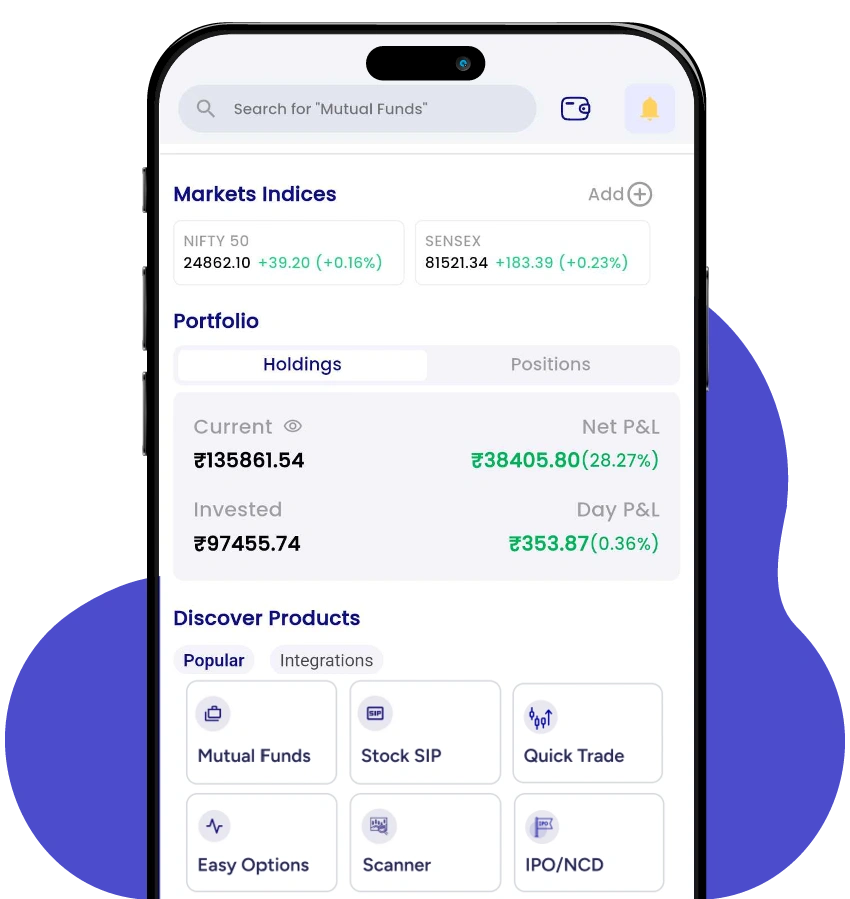Difference Between Direct vs Regular Mutual Funds
- 11th September 2025
- 11:00 AM
- 7 min read
In India, the mutual fund sector is seeing a growth of 20% CAGR in its total Assets Under Management (AUM) over the previous 10 years. This highlights the increasing interest of Indian investors towards such investment schemes.
However, to begin with mutual fund investments, learning to differentiate between a direct vs regular mutual fund is important.
Read this blog and find out how factors like asset values, expense ratios, etc., differ and shape your investment decision.
What are Direct Mutual Funds?
Before delving into direct vs regular mutual funds, you must clarify the concept of a direct mutual fund. Here is a conceptual breakdown of such services:
- When you see such a fund, it means you can buy it directly from an Asset Management Company (AMC).
- About 44 registered AMCs are available in India, and you can invest directly in such funds using the website, mobile app, or, if available, visiting their branch offices.
- A direct mutual fund option does not involve any middleman, such as a mutual fund distributor. This eliminates the additional commission and lowers the expense ratio.
What are Regular Mutual Funds?
To set some clear distinctions between a direct vs regular mutual fund, understanding what a regular plan means is also important. As of the financial year 2024-2025, there are about 12.95 crore investor accounts or folios, underscoring the importance of their following services:
- Here, the mutual fund distributors act as an intermediary between the AMC and you. Such individuals, with their experience and market knowledge, can help you pick the right fund.
- Once you choose the right mutual fund investment plan, distributors handle KYC requirements and other formalities.
- However, they charge an additional commission to the AMC for these services, which eventually applies to you. This increases the overall expenses of fund investments.
Key Difference between Direct and Regular Mutual Funds
Based on factors like return potential, Net Asset Value, expense ratio, etc., here are 5 key differences between direct vs regular mutual funds:
| Features | Direct Mutual Fund | Regular Mutual Fund |
| Expense ratio | In terms of expense ratio, a direct fund also charges less. For example, for a mutual fund scheme, the expense ratio of the direct option can be up to 0.70% | The expense ratio for the regular fund is much higher. For instance, for the same fund, regular plans might impose a 2.34% expense ratio higher than direct plans. |
| Return | Since direct funds involve no intermediary, the average return potential is high. For instance, if the yield of a fund is 11.7%, then after expenses, it might provide you with an 11% return. | Due to the involvement of fund distributors and their commission, the return potential is affected. A regular plan with an 11.5% yield can provide you with around 9% return after expenses. |
| Net Asset Value | Due to lower involved costs, the Net Asset Value can be high. | Due to the expense ratio being built in, NAV might be slightly lower. |
| Suitability | Suitable for self-directed or experienced mutual fund investors. | If you are new to investments or need help choosing the right fund, a direct plan is suitable for you. |
| Ease of use | Most AMCs provide online apps or portals which invest faster. However, the initial research for an informed decision requires time and effort. | Provides a more hands-off approach for investors. Here, as the distributor helps choose the fund, you do not need to dedicate time or effort to research. |
With PL Capital Group – Prabhudas Lilladher, investments are now made easier. Download the PL Capital app, fulfil your KYC and start investing in equities, mutual funds, and more today!
Understanding Direct vs Regular Mutual Funds in a Portfolio
Now that you know the difference between regular and direct mutual fund, you can locate which one is direct and which one is available as a regular plan easily by looking for the following factors:
-
Check the Fund Name
Before choosing a mutual fund and investing, one quick and easy method is to carefully check the name of the fund. Usually, both a direct and a regular plan are available for a certain fund. Check if there is the term Direct or DIr, which indicates a direct fund. If ‘Regular’ or ‘Reg’ is mentioned for the same fund, it represents the regular option of the same fund.
-
Check the Consolidated Account Statement
When there are regular transactions in your mutual fund’s folio, you receive a CAS every month, or otherwise every 6 months. Check the field called ‘Advisor’ in your CAS, and if there is an ARN number mentioned, it is a regular plan. Otherwise, it is a direct plan.
-
Other Factors
You can do online research before choosing the right mutual fund. Apart from the CAS or the phrases Direct or Regular, you can check for NAV and expense ratio to differentiate between a direct vs regular mutual fund. For example, a fund with a higher expense ratio and lower NAV might be a regular plan.
With PL, you can invest in equities, mutual funds and more in a few simple steps and completely online. Download the PL Capital app, fulfill your KYC and start investing today!
Conclusion
When investing in mutual funds, especially if you are a beginner, you must have a clear idea about a direct vs regular mutual fund. As the name implies, you can directly invest in a regular fund via an AMC’s portal. On the other hand, a mutual fund distributor helps you with choosing the right fund option for an optimised return at an additional commission.
Frequently Asked Questions
1. Which is better, a direct or a regular mutual fund?
If you are confident in investing on your own, a direct plan might get you a higher return at a lower expense. However, if you are a new investor and want guidance on fund investments, a regular fund is better, but it comes with an additional commission.
2. How will I know the difference in the TER of regular and direct plans?
The TER or Total Expense Ratio differs between a direct and a regular plan. Typically, the expense ratio of a regular option is 0.5% to 1% than the direct plan. Occasionally, the difference can be close to 2% for some funds.
3. Can I switch from a regular to a direct plan?
Yes, you can switch from a regular plan to a direct plan while you are invested in a fund. However, consider additional costs such as the exit load. A 1% exit load applies if you exit a fund after 1 month of investment. However, it differs depending on fund policies.
4. What is the disadvantage of direct mutual funds?
The main disadvantage is the commission structure that increases your overall expenses. Additionally, you must be cautious about the potential bias of fund distributors towards a certain fund offering higher commission.





